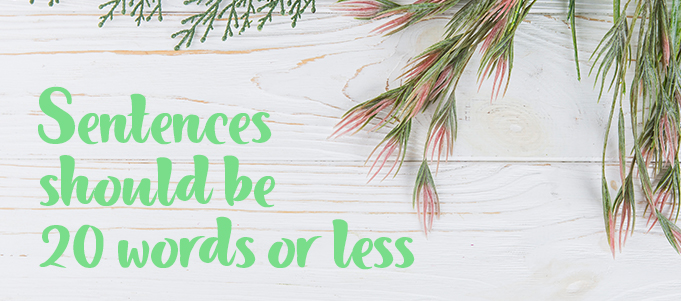Content Marketing
 A new season is a great time to dust off your copywriting skills and add some new tips to your toolbox. In this article, we’ll offer 5 tips to help you improve your financial institution’s blog posts.
A new season is a great time to dust off your copywriting skills and add some new tips to your toolbox. In this article, we’ll offer 5 tips to help you improve your financial institution’s blog posts.
Keep paragraphs short.
How long should a paragraph be? There is no one answer to this question. Conventional wisdom will tell you to aim for three-five sentences. However, one-sentence paragraphs have also become trendy online.
Your guiding light for paragraph creation should be: stick to one idea. If you can convey that idea in one sentence, great. Three-sentence paragraphs are also fine; just remember to put your main topic in the first sentence.
We all know that people tend to skim when reading online. So, shorter paragraphs help readers understand main points better. Aim for a mix of paragraph lengths. A blog article full of one-sentence paragraphs can sound clipped. As with sentences, mixing it up with short and longer paragraph lengths provides a nice rhythm.
Bullet point lists are a useful tool for breaking up paragraph length and helping your readers navigate through the main ideas in your article.
Use the rule of three.
This rhetorical device is often used in speeches, but it is also effective on the page.
- Visitors to your financial institution’s website are usually looking for specific information or researching a type of product.
- Humans generally can’t hold more than 3-4 items in their short-term memory.
- Grouping ideas in threes or repeating a keyword or phrase three times can make your content more interesting and memorable.
Ready to try the rule of three in your next blog post? Here are the best ways to use this rhetorical device in your writing
Give three examples.
Writing a guide for first-time homebuyers? List three types of first-time buyers such as young couples, single people, and families.
Organize by three.
Organize blog posts into three sections: introduction, body (where you make your main points), and conclusion. In other words, tell them what you’re going to write about, write about it, and then tell them what you wrote about.
Use tricolons.
A series of three parallel words or phrases. For example, “Veni, vidi, vici” is from Shakespeare’s Julius Caesar and can be translated to “I came, I saw, I conquered.”
Did you notice we included three points in each list? Once you start thinking about the rule of three, it’s easy to find it everywhere. You can also apply this rhetorical device to the images that accompany your blog posts.
Let subheadings work for your writing.
 A good subheading helps your reader by making content easier to skim and digest. Subheadings provide structure in both shorter and longer pieces of content. So, make your subheadings work for your writing by following these tips:
A good subheading helps your reader by making content easier to skim and digest. Subheadings provide structure in both shorter and longer pieces of content. So, make your subheadings work for your writing by following these tips:
- A subheading should summarize the section to come.
- Try to move beyond labels and questions. While subheadings in the form of questions can be useful for SEO purposes and voice search, you can still include some non-question subheadings that distill the essence of the section into a short sentence.
- Create a sense of progression from one subheading to the next.
- Focus on the positive and communicate benefits.
- Don’t be cheesy. Depending on the topic, it may be appropriate to keep a lighter tone, but stay away from puns or corny jokes.
- Be consistent with the length of each subheading.
- No false advertising or “clickbait” subheadings just to lure the reader in. Readers are savvy and may not give you a second chance after tricking them once.
Go easy on bullet points.
When used strategically, bullet points can help guide readers in the way that subheadings do. Bulleted lists emphasize and denote important information, while breaking up paragraphs and adding visual variety to a blog article.
However, as with anything in life, there can be too much of a good thing. If you overuse bullet points or attach paragraphs of text to each bullet, you’ll just end up making your article harder to read and remember.
Follow these tips for better bullet point usage:
- No more than one sentence per bullet
- Parallel construction (i.e. all sentences or all fragments)
- Maximum of six bullet points
When listing a step-by-step process, use numbers instead of bullet points to give your readers a clear sense of the beginning and end.
Keep sentences short and sweet.
 20 words or less is a good rule of thumb for sentence length. Shorter sentences are easier to read and skim. And, from an accessibility point of view, shorter sentences are easier for people with reading or learning disabilities to digest.
20 words or less is a good rule of thumb for sentence length. Shorter sentences are easier to read and skim. And, from an accessibility point of view, shorter sentences are easier for people with reading or learning disabilities to digest.
The longer your sentences, the less readable your article becomes. However, uniformity in sentence length can become boring. You should still try to vary your sentence length to keep it interesting. When in doubt, don’t obsess over word count. Read your sentences aloud and break things up where it feels natural to do so.
Need help with your copywriting?
Creating quality blog content can be time consuming, especially when most bank marketers already have a very full to-do list. Take the stress out of getting great copy for your bank website—use a full-service agency like BankBound with professional, experienced writers on staff to meet all your copywriting needs. We offer a full range of digital marketing solutions including content. Contact us to learn more!

